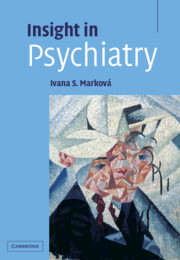Book contents
- Frontmatter
- Contents
- Dedication
- Preface
- Part I Historical and Clinical
- Part II Conceptual
- 6 The conceptualisation of insight
- 7 The relational aspects of insight: the ‘object’ of insight assessment
- 8 Towards a structure of insight: awareness and insight, an essential distinction?
- 9 Towards a structure of insight: the relationship between awareness and insight
- References
- Index
7 - The relational aspects of insight: the ‘object’ of insight assessment
from Part II - Conceptual
Published online by Cambridge University Press: 22 October 2009
- Frontmatter
- Contents
- Dedication
- Preface
- Part I Historical and Clinical
- Part II Conceptual
- 6 The conceptualisation of insight
- 7 The relational aspects of insight: the ‘object’ of insight assessment
- 8 Towards a structure of insight: awareness and insight, an essential distinction?
- 9 Towards a structure of insight: the relationship between awareness and insight
- References
- Index
Summary
Following on from the previous chapter, in terms of examining some of the conceptual problems underlying the meaning of insight, the focus in this chapter is on another highly important aspect of insight, namely its relational nature. So far, problems of meaning of insight have concentrated simply on the term itself. The differences in the meaning of insight in regards to definitions varying in breadth, detail, components, and otherwise, have been highlighted and difficulties around specifying boundaries of the content of the concept have been identified. Likewise, it has been argued that the nature of the concept of insight is most usefully regarded as a mental state and consequently determined by multifarious elements of which the mental disorder or condition affecting the patient is only one. Additional problems relating to the meaning of the phenomenon of insight have been raised on account of the specific issues involved in the interpretation of a clinical state necessary to the determination of the phenomenon of insight.
It has been apparent, however, both with respect to the exploration of insight in different clinical disorders and with respect to the exploration of insight in a particular clinical disorder, that insight cannot be explored in isolation as some sort of independent entity. Instead, the phenomenon of insight is always manifested or elicited in relation to some aspect of the condition affecting the patient. In other words, insight is a relational concept – or an ‘intentional’ concept in the sense of Brentano (1874/1995).
- Type
- Chapter
- Information
- Insight in Psychiatry , pp. 219 - 242Publisher: Cambridge University PressPrint publication year: 2005



